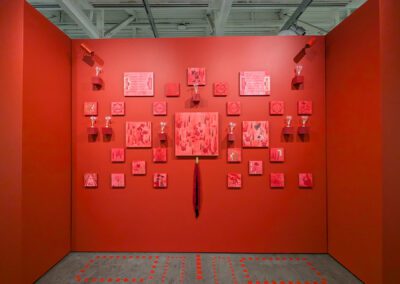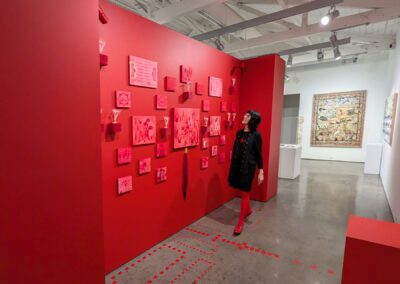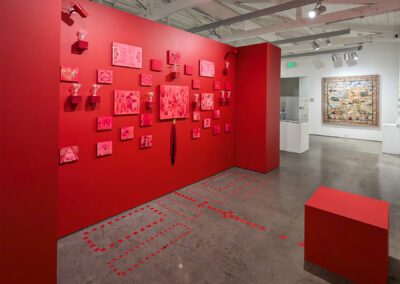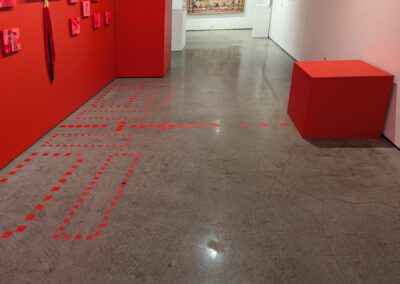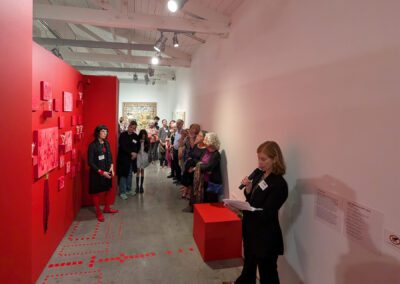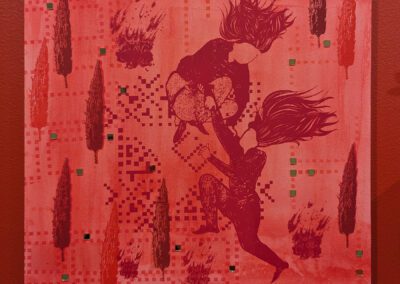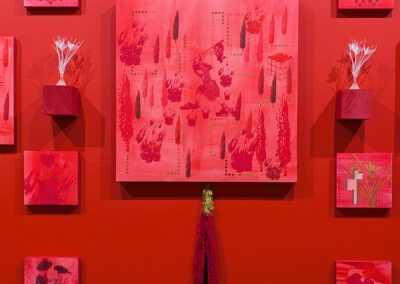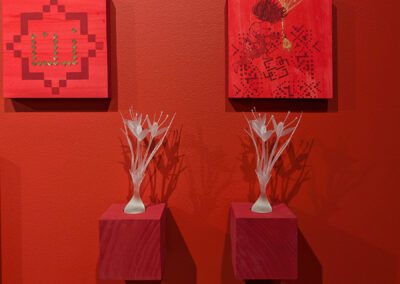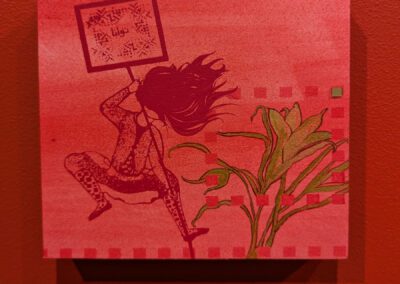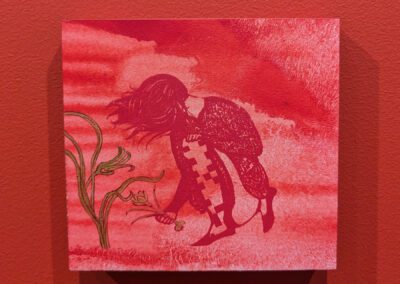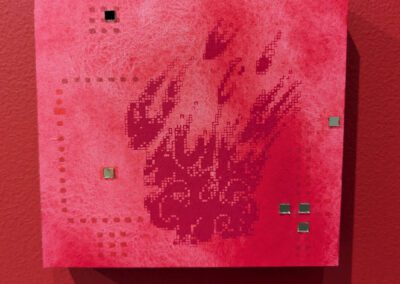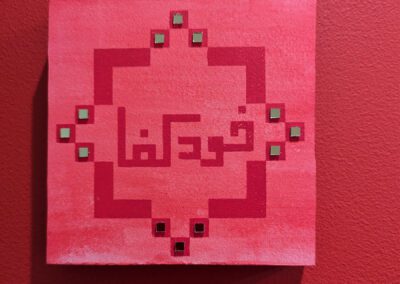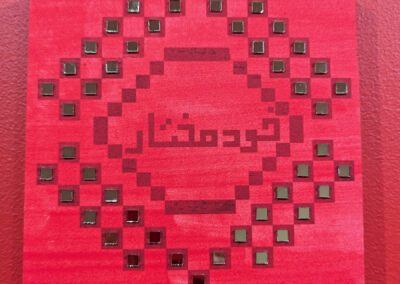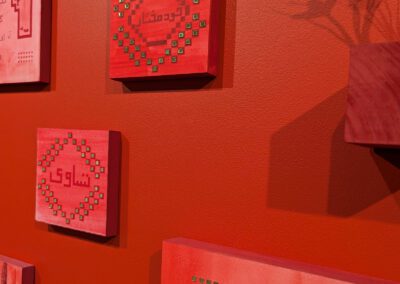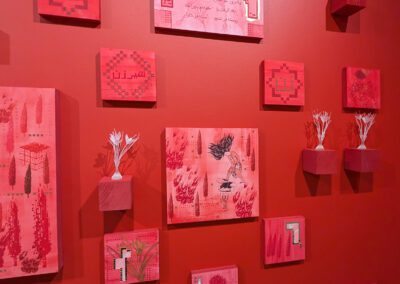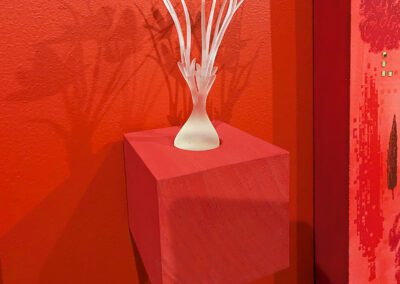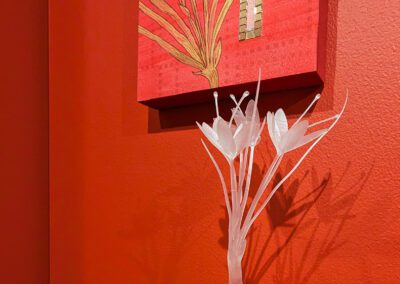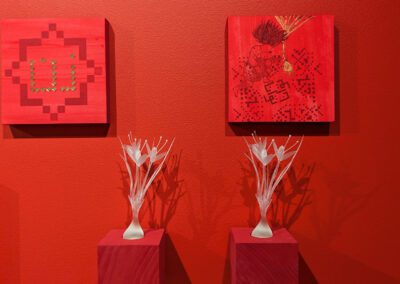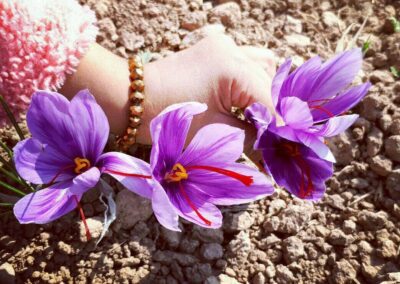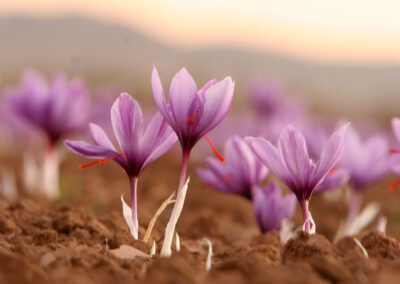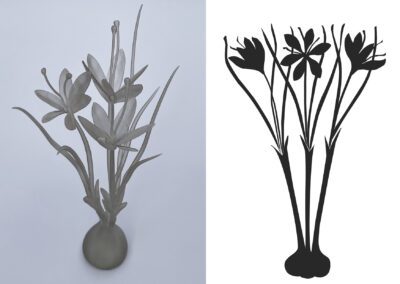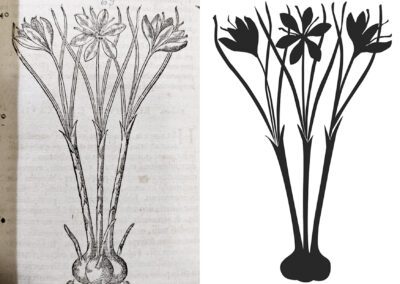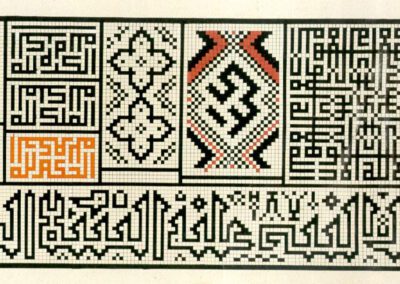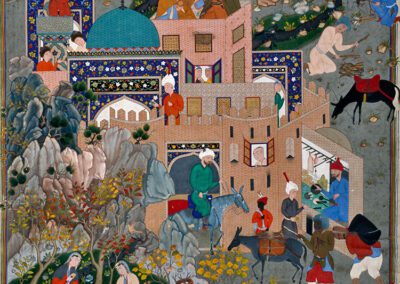I Will Rise in Slow Accession, 2024
Installation at Palo Alto Art Center, Funded by The Palo Alto Art Center Foundation
“I Will Rise in Slow Accession,” a title drawn from a verse in a poem by Iranian poet and activist Simin Behbahani, is a project that expands upon my 2022 work honoring the Women, Life, Freedom movement in Iran- the protest against female subjugation and compulsory hijab and for bodily autonomy. Drawing on historical context in Persian paintings from the late medieval period, I reimagine the garden scenes and characters to reflect on contemporary issues. Traditionally, these paintings featured gardens and other spaces and mainly portrayed male figures engaged in activities often described in Persian poetry, such as scenes from the Shah-Nama (The Book of Kings) by the 10th-century poet Ferdowsi. In this series, guided by Behbahani’s feminist and socio-political poetry themes, I shift the narrative and perspective to claim sovereignty, emphasizing female agency and bodily autonomy. My female action figures are modeled after those found in classical Persian paintings. I draw them as actively subversive, faceless with dramatically billowing hair, and reimagine their roles and affairs. This historical and cultural recontextualizing allows me to explore and assert powerful roles to women and create a dialogue between the past and present. Surrounding these characters, I have crafted the Square Kufic word tiles. Starting in the 12th century, in Iran, these tiles were composed of small square pieces (pixels) to create religious words in Kufic script on facades of buildings using ceramic tiles. I craft my Square Kufic pixel tiles to connote female agency and bodily autonomy using provocative words such as Sheer Zan (brave woman), Raha (free), Khod-Mokhtar (autonomous), Tasaavee (equality), Khod-Kafaa (independent), Zendegee (life), and Tavaanaa (capable). My use of pixels references this historical approach to tile-making while also symbolizing fragmented time and image-making attributes—how micro squares come together to form a macro image or word.
I chose the Eram Botanical Garden in my birthplace of Shiraz, Iran, to imagine the pursuits of my female action figures. Built during the medieval period and expanded in the 19th century, Eram is one of Iran’s nine UNESCO World Heritage gardens. Traditionally, Persian gardens were designed as private spaces that also served political and work-related functions, such as entertaining ambassadors. These historic gardens are representative of diverse and complex architectural, cultural, and contrastingly political environments, offering the potential to explore them beyond their opulent visual aesthetics and healing qualities. On my last visit to Iran, the historic public gardens appeared serene at first glance but gradually revealed a sense of uneasiness as if I was being watched.
Utilizing multimedia and mixed media, including red walls, 3-D saffron crocus sculptures, an Eram Garden floor vinyl plan, hand-made silkscreen and marbling prints, pixel mirrors, CCTV cameras, and the sound of a water fountain, the installation features over twenty pieces. In the installation, I use pixels as tools to visualize the deconstructed Eram Garden and create a fragmented environment, inviting the viewer to experience both harmony and tension simultaneously. Harmony emerges from the consonance of the characters’ actions, the elements of nature, and Kufic word pixel tiles while red introduces the tension, reflecting the surveillance, underlying pressure, and scrutiny faced by women in contemporary Iranian society.
Works and their Media:
Utilizing multimedia and mixed media, including red walls, 3-D saffron crocus sculptures, an Eram Garden floor vinyl plan, hand-made silkscreen and marbling prints, pixel mirrors, CCTV cameras, and the sound of a water fountain, the installation features over twenty pieces. Artworks: silkscreen, gold acrylic, pixel mirror, and marbling prints on paper mounted on wood panels. Size variable from 6×6 inches- 8×8 inches- to 20×20 inches.
Saffron 3-D sculptures are modeled after the depiction of the saffron crocus from a 17th-century medicinal botanical book preserved in the UCSF Library’s collection and manufactured in collaboration with the UCSF Library’s Makers Lab in 2024.
Poem, 1981 by Simin Behbahani (1927-2014), translated into English in 2024.
Confined in a sweatbox, surrounded by the walls
One day, the falling walls will give me free rein
One day, I will bathe in light
& the sun will clothe me in radiant gold
Glimpse of sunrise reflects off my spear
Calling me to the battle at dawn
I will rise in slow accession
Steadily stern, repeatedly rhythmic
One day, a rainbow will manifest in me
Adorning my face in seven colors
I impart the blue petals to the air
Delivering my silk scarf to the wind
I shall chant in the mountains
like Iris calling upon the morning to come
One day I will witness my accession
As the rotten will wither away
Inspiration and Research
Why Female Characters from Late Medieval Persian Paintings? Artist Judy Chicago in an interview with Lucy Lippard in May 2001 said: “It took a hundred years before there was sufficient interest in Mary Cassatt’s work to mount a major retrospective. Imagine what it would have meant to us in terms of our understanding of women’s esthetic achievements if we had been able to see and study Mary Cassatt’s sixty-five-foot mural from the 1893 Women’s Building, portraying women passing down the fruits of knowledge to their daughters- probably the first major feminist work of art, actually, or woman-centered work of art. The fact that it was lost to history allowed Mary Cassatt to be portrayed as Degas’s student. Its presence would have posed a constant challenge to that idea. These losses have to stop. And women can stop them.”
Similarly, what if these historic Persian paintings, constructed by male artists in various Iranian dynasties, portrayed women in active and powerful roles? I challenge the representation of women in these historical paintings with the intention of normalizing powerful images and depictions of females in art today.
Why garden scenes? A section of my work revolves around medicinal botany, specifically saffron crocus. As a child, I regularly explored the public botanical gardens in Shiraz, Iran with my grandmother who firmly believed in the healing powers of herbal medicine and the importance of staying connected to the natural world. Public gardens are unique spaces that involve people, plants, and animals, offering a democratic space for all beings. Historic gardens’ layouts typically follow a geometric quadripartite structure with a focal water feature, connecting aqueducts, and surrounding trees and flowers, along with the strategic placement of pavilions in the center with a vista. Water is crucial for its soothing sound, ornamentation as well as irrigation. In Persian gardens, the pavilions and fountains are decorated with mirror works, and geometric or foliage ceramic tiles, creating a harmonious blend with their surroundings. Traditionally, Persian gardens were designed as private spaces that also served political and work-related functions, such as entertaining ambassadors.
All the attributes above make these historic gardens representative of diverse and complex architectural, cultural, and contrastingly political environments, offering potential to explore them beyond their opulent visual aesthetics and healing qualities.
Why Saffron Crocus? Iran cultivates and produces the majority of the world’s saffron crocus and saffron spice, a medicinal plant that has healing properties. Production of 1 kilogram of saffron spice, requires handpicking 150,000 crocus flowers. The labor-intensive harvesting process is mainly done by women, for three weeks, in the late cold fall season in Iran’s northeast each year. Iranian saffron farmers struggle due to suffocating economic sanctions, endemic drought from global warming, and increasing shipping and labor costs. I use saffron as a metaphor for cultural and contemporary economic and agricultural challenges, convolved with ongoing political issues under the theocracy in Iran. The 3-D saffron crocus sculptures included in the installation were manufactured in collaboration with the UCSF Library Makers Lab in the Spring of 2024. The saffron crocus sculptures in hand-made cube vases are modeled after the depiction of the saffron crocus from a 16th-century medicinal botanical book preserved in the UCSF Library’s collection.
Why Pixelated Elements? The tile design was inspired by those found in the Topkapı scroll, a late medieval Iranian document that compiled 114 architectural geometric patterns and tiles composed of Square Kufic scripts, housed at the Topkapı Palace in Istanbul, Türkiye. Starting in the 12th century, these tiles were composed of small square pieces (pixels) used to create intricate religious words in Kufic script, and motifs such as eight and twelve-pointed stars, on the domes, minarets, or facades of buildings using ceramic tiles. Pixels and grids are also prominent in Iranian crafts and carpet weaving. The unity achieved through these micro pixels, piece by piece, has formed magical macro images of the universe on buildings using ceramic tiles and images of Persian gardens on carpets using wool or silk. I use these word-tiles to facilitate powerful denotation and connotation beyond their harmonic visuals and I continue to repurpose them in my works. In I Will Rise in Slow Accession, I craft my Square Kufic pixel tiles to connote female agency and bodily autonomy using provocative words in Persian, such as Sheer Zan (brave woman), Raha (free), Khod-Mokhtar (autonomous), and Tavaanaa (capable).
My use of pixels references this historical approach to tile-making while also symbolizing fragmented time and image-making attributes—how small squares come together to form an image or word. I decorate some of my tiles and images using pixel mirrors as a reference to the Iranian mirrorwork (Āina-kāri), where geometric, calligraphic, or foliage forms adorn buildings using cut mirrors and create a sense of awe and divinity.
I use the cube to represent a three-dimensional pixel with which I imbue multifaceted significance, encompassing philosophy, geometry, and religion. Cube symbolizes a wide range of meanings, reflecting the complexity of form and our associations with it. In the philosophy of Plato, the cube is a Platonic solid that represents the earth. For me, the cube is also a reminder of the Kaaba (the Muslim holy site).

